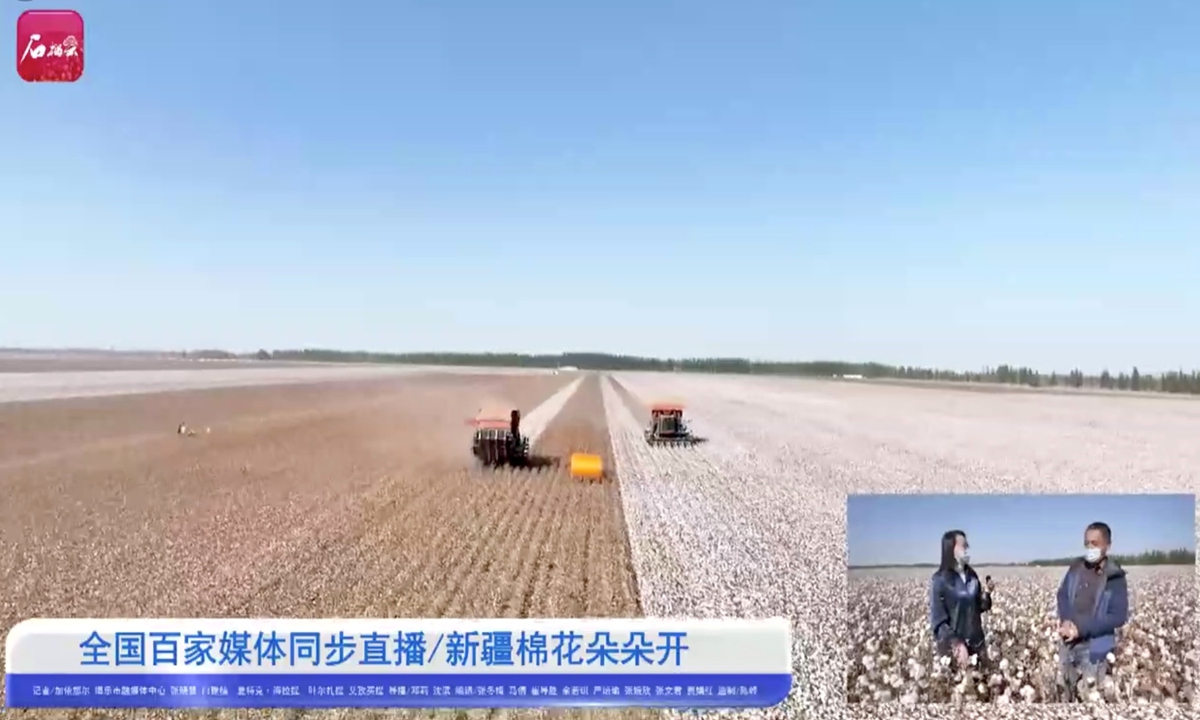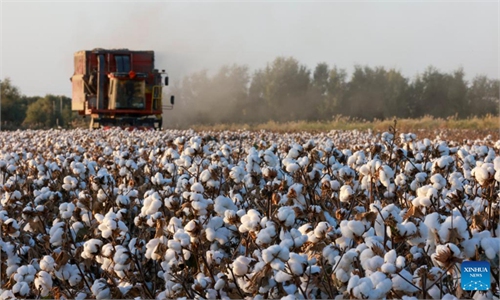Xinjiang to see machines harvesting 80% of cotton, a renewed slap against ‘forced labor’ lies

Screenshot of the livestreaming session on October 12, 2022
From north to south, millions of hectares of cotton fields in Northwest China's Xinjiang Uygur Autonomous Region are blooming like a "white sea of flowers" with large harvesters shuttling and racing against time to lock in this year's harvest. To let more people learn about the process of mechanized cotton harvesting in Xinjiang's five largest cotton-growing areas, hundreds of media outlets across the country broadcast the process live on Wednesday, attracting nearly 330,000 netizens to watch and share the happiness.With the improvement of the mechanization of cotton production in the whole region, the per capita management area of machine-picked cotton has reached more than 200 mu (13.3 hectares), and the management efficiency is three to five times than that of hand-picked cotton, significantly reducing the labor intensity of farmers, local cotton farmers said cheerfully in a livestreaming session.
"I planted more than 1,000 mu of cotton this year, with a yield of about 400 kilograms per mu. Since the spring season, we have adopted precision-seeding technology guided by the BeiDou Satellite. Now, the vertical error of the sowing line is really small, which ensures that the cotton picker can be used for harvesting," cotton farmer Chen Yukao said in the session.
"In 2022, all the cotton in my home is collected by machine, and it is expected that the harvest will be finished in four days," Chen noted. "Picking cotton with machine reduces our costs and improves efficiency. We are happy about that."
Chen's remarks were a blow to previous untenable lies to hype so-called forced labor in Xinjiang. Some netizens praised the splendid views of agricultural modernization, saying that they were watching the planting of new clothes. Many made jokes saying that perhaps the US Embassy will tweet that China is forcing machines to work.
In addition to the regular cotton picking, this year the cotton fields in the Bortala Mongolian Autonomous Prefecture also welcomed a new "guest" - livestream influencers who help sell cotton products.
While cotton farmers patrol the fields and "supervise" the picking machines, the host, Chen Ting, simultaneously sells cotton products on livestream platforms. According to Chen, some of the best cotton products are hand-picked quilts, which have strong levels of warmth, comfort and air permeability, as well as cotton cultural and creative products, such as cotton bouquets.
Chen said she chose to broadcast from the farmland because her audiences enjoy seeing the white cotton fields, which makes them very happy and eager to buy goods. "As a new media practitioner and a native of Bortala Mongolian Autonomous Prefecture, it's my pleasure to use my own traffic to publicize our high-quality products," she said.
Chinese netizens and analysts said that the wider livestreaming of cotton planting in Xinjiang region is an epitome of the industrialization of agriculture in the region and also a slap in the face of those who are lying through their teeth.
In addition to Chen Ting, two young men from Bazhou Jifei Agricultural Aviation Technology Co who were born in the 1990s made their own contributions to generating income from cotton this year.
At the beginning of 2021, the company launched the "super cotton field" project on 3,000 mu of high-standard farmland in Yuli county, Bayingolin Mongolian Autonomous Prefecture.
Ai Haipeng and Ling Lei, the two managers of the project, used the BeiDou navigation system to build a digital agricultural service platform, and installed devices such as soil sensors, weather stations and agricultural recorders next to the cotton fields, allowing them to remotely manage the cotton fields from home.
Now, thanks to help of robotics, artificial intelligence and other high-tech methods, growing cotton has become easier and faster. "At present, our cotton yield is about 457 kilograms per mu on average, an increase of more than 200 kilograms from 2021. Our drones can deliver 1,000 mu of medicine a day, which is beyond the reach of humans," Ai said. "We hope to use the harvest of our super cotton field, with white cotton, to meet the 20th National Congress of the Communist Party of China."
Ai pointed out that smart agricultural technology, which saves water, fertilizer and other inputs, can reduce the use of agricultural production materials and reduce their cost. The cost of water and electricity alone can be reduced by 190 yuan per mu.
Under the advantages of the cooperative model, all the harvested cotton will be made into commodities to meet market demand. "At present, because the overall price of cotton in Xinjiang has advantages, there is a good profit for the downstream, and customers are very motivated to buy," an owner of a cotton manufacturing factory told the Global Times on Wednesday. Other cotton growers who produce and sell their own cotton told the Global Times that they have received more orders this year than usual.
"We bought the best processing machines according to the needs of domestic and international customers to meet the needs of home textiles, clothing and other products," a factory director from Bachu county, Kashi Prefecture, said on Wednesday.
In the eyes of Xinjiang residents, cotton is the flower of happiness and wealth. As many netizens said, facts speak louder than words. The scientific techniques used to pick cotton in Xinjiang have proved that the claims of "forced labor" are pale and groundless.
Machines are expected to do over 80 percent of the picking work in Xinjiang's harvest season this year, local authorities said.
Currently, over 7,000 machine cotton pickers have been put into use during the harvest season in Xinjiang, according to the regional department of agriculture and rural affairs.
Xinjiang's overall cotton growth this year is better than that of last year, and its technological cotton planting level has been significantly improved, said the department.
The cotton and textile industry is one of the pillar industries in the region. Cotton output in Xinjiang topped 5.13 million tonnes in 2021, accounting for 89.5 percent of the country's total.
Zhu Haoning contributed to this story

